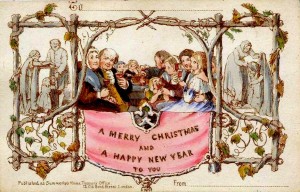Christmas rapidly approaches, and I suspect no one who reads this blog will be surprised to see a post about Christmas in the Victorian era. Predictability is good, right?
Although Christmas as we know it today does celebrate the birth of Jesus (even though there is evidence to suggest he was not born in December), the many and varied traditions surrounding the holiday predate that event by thousands of years. The Yule log and singing of carols are Scandinavian in origin, a celebration of the Winter Solstice. The Christmas tree and the giving of gifts, some say, have their origins in the Roman festival of Saturnalia. The twelve days of Christmas are reportedly a throwback to the ancient Mesopotamian festival of Zagmuth, a celebration of their god Marduk’s defeat of the monsters of chaos each winter.
But Christmas as we celebrate it today has its origins in Victorian England. The Christmas tree was largely unknown in England until the German Prince Albert brought the tradition to his adopted country upon his marriage to Queen Victoria. After this engraving ran in the Illustrated London News in 1848, Britons flocked to put trees in their houses.


Charles Dickens’ A Christmas Carol was published in 1843, and created a resurgence in the singing of Christmas carols, giving of gifts, and giving charity to the poor.

The first Christmas card is believed to have originated in 1840s England as well. In 1843, Henry Cole, an English civil servant, commissioned an artist, John Callcott Horsley, to create a card for Christmas. In 1880, 11.5 million Christmas cards were sold.
Christmas crackers, which for some reason never caught on in the U.S., were invented by Tom Smith, a London confectioner, in 1847. Originally designed to help market his own bon bons, he added a popping sound upon opening (inspired by the crackling sound of a log on the fire), and inserted sweets, and a message. Today’s crackers also include a paper crown, a small toy, a sweet, and a message akin to that inside a fortune cookie.
Gifts given at Christmas were modest in Victorian times–small trinkets, treats, fruits, and nuts–and were hung on the Christmas tree. As presents got bigger, they were stashed under the tree. Decorating for Christmas with evergreens, a medieval tradition, was adopted wholeheartedly by the Victorians. Family, so important to the Victorians, became the centerpiece of the Christmas celebration, and that tradition too we hold dear today.
And so I wish all of you a joyous holiday season, no matter which winter festival you celebrate. May you be blessed with family, friends, peace, and happiness during this season and the year to come.
Sources:
www.historyofchristmas.net
www.bbc.co.uk/victorianchristmas/history.shtml
www.history.com/topics/christmas/history-of-christmas
en.wikipedia.org/wiki/Henry_Cole
www.victoriana.com/christmas/card1st-99.htm
en.wikipedia.org/wiki/Christmas_cracker
